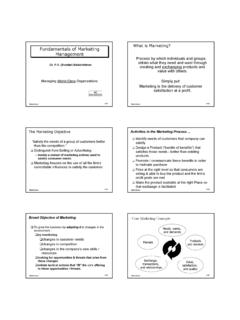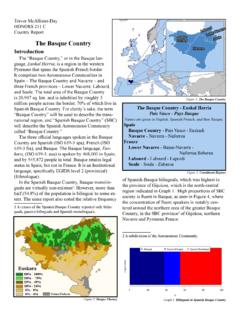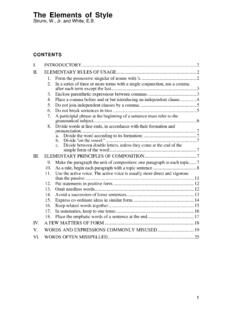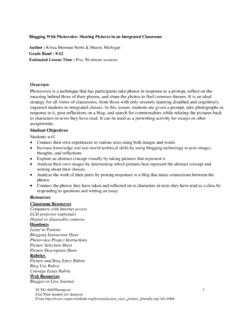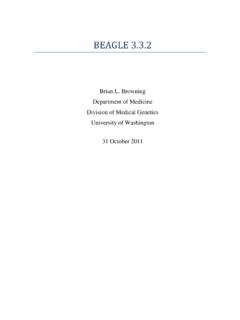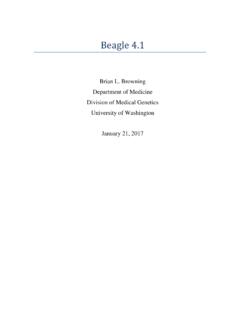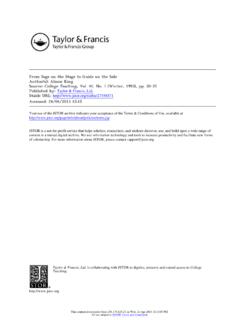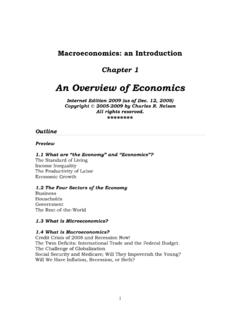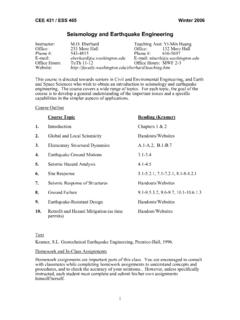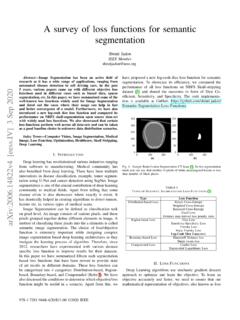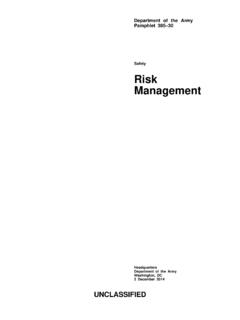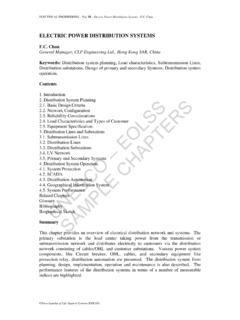Transcription of Chapter 1 Introduction to Portfolio Theory
1 Chapter 1 Introduction to PortfolioTheoryUpdated: August 9, Chapter introduces modern Portfolio Theory in a simplified settingwhere there are only two risky assets and a single risk-free Portfolios of Two Risky AssetsConsider the following investment problem. We can invest in two non-dividend paying stocks Amazon (A) and Boeing (B) over the next denote monthly simple return on Amazon and denote the monthlysimple return on stock Boeing. These returns are to be treated as randomvariables because the returns will not be realized until the end of the assume that the returns and are jointly normally distributed,and that we have the following information about the means, variances andcovariances of the probability distribution of the two returns: = [ ] 2 =var( ) = [ ] 2 =var( ) ( ) =cov( ) =cor( )= ( )We assume that these values are taken as given.
2 Typically, they are estimatedfrom historical return data for the two stocks. However, they can also besubjective guesses by an 1 Introduction TO Portfolio THEORYThe expected returns, and , are our best guesses for the monthlyreturns on each of the stocks. However, because the investment returns arerandom variables we must recognizethat the realized returns may be differentfrom our expectations. The variances, 2 and 2 , provide measures of theuncertainty associated with these monthly returns. We can also think of thevariances as measuring the risk associated with the investments. Assets withhigh return variability (or volatility) are often thought to be risky, and assetswith low return volatility are often thought to be safe.
3 The covariance gives us information about the direction of any linear dependence betweenreturns. If 0then the two returns tend to move in the same direction;if 0the returns tend to move in opposite directions; if =0thenthe returns tend to move independently. The strength of the dependencebetween the returns is measured by the correlation coefficient If is close to one in absolute value then returns mimic each other extremelyclosely, whereas if is close to zero then the returns may show very 1 Two risky asset Portfolio informationTable gives annual return distribution parameters for two hypotheticalassets A and B.
4 Asset A is the high risk asset with an annual return of =17 5%and annual standard deviation of =25 8% Asset B is alower risk asset with annual return =5 5%and annual standard deviationof =11 5% The assets are assumed to be slightly negatively correlatedwith correlation coefficient = 0 164 Given the standard deviations andthe correlation, the covariance can be determined from = =( 0 164)(0 0258)(0 115) = 0 004875 In R, the example data is> > = > = ^2> > = > = ^2> = > = * * PORTFOLIOS OF TWO RISKY ASSETS3 2 2 : Example data for two asset Portfolio problem is set-up as follows.
5 We have a given amount ofinitial wealth 0 anditisassumedthatwewillexhaustallofourw ealthbetween investments in the two stocks. The investment problem is to decidehow much wealth to put in asset A and how much to put in asset B. Let denote the share of wealth invested in stock A, and denote the shareof wealth invested in stock B. The values of and can be positive ornegative. Positive values denotelongpositions (purchases) in the values denoteshortpositions (sales).1 Since all wealth is put intothe two investments it follows that + =1 If asset is shorted, thenit is assumed that the proceeds of the short sale are used to purchase moreof asset Therefore, to solve the investment problem we must choose thevalues of and Our investment in the two stocks forms aportfolio,and the shares and are referred to asportfolio sharesor weights.
6 The return on the portfolioover the next month is a random variable, and is given by = + ( )which is a linear combination or weighted average of the random variables and .Since and are assumed to be normally distributed, is also normally distributed. We use the properties of linear combinations ofrandom variables to determine the mean and variance of this Portfolio expected return and varianceThe distribution of the return on the Portfolio ( ) is a normal with mean,variance and standard deviation given by1To short an asset one borrows the asset, usually from a broker, and then sells it.
7 Theproceeds from the short sale are usually kept on account with a broker and there oftenrestrictions that prevent the use of these funds for the purchase of other assets. The shortposition is closed out when the asset is repurchased and then returned to original the asset drops in value then a gain is made on the short sale and if the asset increasesin value a loss is 1 Introduction TO Portfolio Theory = [ ]= + ( ) 2 =var( )= 2 2 + 2 2 +2 ( ) =SD( )=q 2 2 + 2 2 +2 ( )That is, ( 2 ) The results ( ) and ( ) are so important to Portfolio Theory that it isworthwhile to review the derivations.
8 For thefirstresult( ),wehave [ ]= [ + ]= [ ]+ [ ]= + by the linearity of the expectation operator. For the second result ( ), wehavevar( )= [( )2]= [( ( )+ ( ))2]= [ 2 ( )2+ 2 ( )2+2 ( )( )]= 2 [( )2]+ 2 [( )2]+2 [( )( )]= 2 2 + 2 2 +2 Notice that the variance of the Portfolio is a weighted average of the variancesof the individual assets plus two times the product of the Portfolio weightstimes the covariance between the assets. If the Portfolio weights are bothpositive then a positive covariance will tend to increase the Portfolio variance,because both returns tend to move in the same direction, and a negativecovariance will tend to reduce the Portfolio variance.
9 Thusfinding assets withnegatively correlated returns can be very beneficial when forming portfoliosbecause risk, as measured by Portfolio standard deviation, is reduced. Whatis perhaps surprising is that forming portfolios with positively correlatedassets can also reduce risk as long as the correlation is not too 2 Two asset portfoliosConsider creating some portfolios using the asset information in Table Portfolio is an equally weighted Portfolio with = =0 5 PORTFOLIOS OF TWO RISKY ASSETS5( )-( ), we have =(0 5) (0 175) + (0 5) (0 055) = 0 115 2 =(0 5)2 (0 067) + (0 5)2 (0 013)+2 (0 5)(0 5)( 0 004866)
10 =0 01751 = 0 01751 = 0 1323 This Portfolio has expected return half-way between the expected returnson assets A and B, but the Portfolio standard deviation is less than half-way between the asset standard deviations. This reflects risk reduction viadiversification. In R, the Portfolio parameters are computed using> > > = * + * > ^2* + ^2* +2* * * > = sqrt( )> [1] > [1] > [1] , consider a long-short Portfolio with =1 5and = 0 5 In thisportfolio, asset B is sold short and the proceeds of the short sale are used toleverage the investment in asset A. The Portfolio characteristics are =(1 5) (0 175) + ( 0 5) (0 055) = 0 235 2 =(1 5)2 (0 067) + ( 0 5)2 (0 013)+2 (1 5)( 0 5)( 0 004866)=0 1604 = 0 1604 = 0 4005 This Portfolio has both a higher expected return and standard deviation thanasset A.
